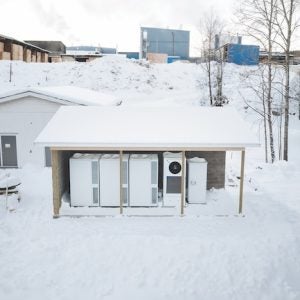
Surging demand for electricity, soaring electricity prices and supply risks are creating an imperative for innovative ways to control energy costs, and increase resilience by diversifying commercial and industrial power sources.
US electricity prices are soaring amidst growing demand, extreme temperatures, gas price volatility, inflation, and the cost of new grid infrastructure and upgrades. Rising energy costs were a major factor in the recent US election, and it is unclear whether the new president will be able to keep his promise to lower energy bills by boosting energy production, because production rates are at the mercy of producers.
Meanwhile, recent power cuts in the wake of Hurricane Milton offer a powerful illustration of the growing grid reliability challenges caused by severe weather events. Despite gains in energy efficiency, overall demand for electricity will increase over the coming decade with the accelerating electrification of sectors from heating to transport. Combined with increased demand from accelerating reindustrialisation and electrification of industry, this could increase costs and energy supply risks for key US industries ranging from semiconductors to electric vehicle manufacturing.
There is a need for more diverse solutions including on-site solar generation and storage to provide more affordable, secure power for commercial and industrial buildings and simultaneously offer more flexible capacity for grids. Commercial and industrial building owners adding energy storage will maintain their connection to utilities because the economic returns are realised during on-grid operation. Even though energy storage for buildings is typically purchased for the economic benefits to the building owner, battery energy storage systems can also become an asset to the wider community, including increasing grid reliability and flexibility while reducing the need for expensive transmission upgrades.
The energy challenge facing US industry
There has been an estimated 28% rise in US electricity prices since 2019, driven by a potent cocktail of inflation, surging demand, volatile gas prices, and the costs of adapting grids to higher temperatures . Energy-intensive industries face high-demand charges, in addition to rising rates per kilowatt hour. There is a correlation between a higher proportion of renewable generation and more fluctuating, complex tariffs, and energy storage is well suited to monetise these complex rate structures.
This comes amidst a projected 13-15% annual increase in energy demand driven by resurgent US manufacturing and the digitalisation and electrification of the economy, jeopardising power supplies to industries such as manufacturing. The USA is already facing power grid congestion, worsened by the estimated 2600 GW of new generating and storage capacity currently stuck in interconnection queues. To compound the problem, the increasing incidence of extreme weather events is undermining grid reliability.
As US industries increasingly switch to electric power, this is leaving them exposed to increasing prices and supply risks. At the same time, the USA’s accelerating reindustrialisation and industrial electrification is putting extra strain on power grids. Increasing electricity supply risks and costs are creating an urgent need to diversify commercial and industrial power sources, ensuring more resilient and affordable supplies.
Pioneering industries adopt electricity storage and generation
However, pioneering energy-intensive industries are now reducing their energy costs by adopting smart on-site battery energy storage systems (BESS) that reduce costs and provide backup power. These technologies strategically store surplus energy, often from on-site solar energy during times of the day with lower time-of-use rates, and discharge during times with higher time-of-use rates, simultaneously reducing energy costs and relieving the burden on the grid.
In addition, utilities in California and other states charge customers based on their highest monthly consumption, typically in 15-minute intervals. Some US industrial facilities have been using our battery energy storage systems for demand charge management, where power is discharged when high demand is forecast, to reduce the demand charges. Another revenue stream is time-of-use management, where batteries can be discharged during the time of day with the highest time-of-use (TOU) rates. For example, California’s TOU rates are lowest during peak times for solar generation, at midday. Battery energy storage systems enable this solar power to be stored and discharged in the evening when TOU rates are at their highest, both reducing energy costs and relieving demand on the grid. Modular battery energy storage systems can now be rapidly assembled onsite and scaled up in line with demand, ensuring adaptation to increased commercial and industrial energy needs.
With extreme weather events creating more grid reliability challenges, on-site battery energy storage can also provide backup power for critical industrial facilities in the event of power grid outages. Intelligent software is required to enable batteries to strategically discharge energy to flatten out frequency or voltage fluctuations, preserving power quality as well as continuity.
Crucially, onsite storage can convert energy from net cost to net revenue by enabling commercial and industrial buildings to reduce consumption when it would most benefit the grid. There are also a range of additional revenue streams for commercial and industrial consumers obtainable from providing frequency and voltage regulation and demand response services for grids. Providing these services could transform commercial and industrial facilities from a drain on electricity supplies into potential distributed energy resources for power grids.
Market opportunity for distributed energy resources
Increasing recognition of the returns that may be earned are fuelling a growing market for commercial and industrial energy storage. Analysts predict the US distributed energy resource market could grow to a $68 billion per year industry by 2027, with distributed storage alone set to grow by 460%. Industrial and manufacturing flexibility could reach 45 GW over that timeline, creating a major revenue opportunity for industrial facilities with onsite generation and storage capacity. In this way, battery energy storage systems can be mutually beneficial for utilities and their customers, simultaneously reducing energy costs and generating extra revenues for storage owners while relieving demand and providing flexible capacity for the grid during peak periods.
At state level, New York has been pioneering a policy that aims to get 70% of its electricity from renewable sources by 2030, and also plans to draw a significant share from distributed energy resources. This model has seen everything from small-scale to community-scale battery installations providing a diverse range of power sources to ensure flexibility and resilience during peak periods such as heat waves. High-powered battery energy storage systems can support community-scale storage projects co-located with renewable energy production that provide front-of-the-meter flexibility for power grids. For example, Socomec has helped roll out microgrids for the Corrèze rural community in southern France harnessing solar photovoltaic installations and battery storage to provide continuous power in the event of outages.
These examples point the way forward to a more flexible and multi-faceted clean electricity network based on a complementary relationship between utilities and customers with onsite energy storage and generation.
Towards a new model of distributed power
The Biden administration’s Inflation Reduction Act (IRA) and CHIPS and Science Act have spurred a reindustrialisation and manufacturing renaissance in the USA, and surging demand for power. This could create new costs and risks for US manufacturers and industrial facilities. As rising extreme weather events, surging demand, and the transition to intermittent energy sources create more volatile electricity costs and supplies, there is a growing need for commercial and industrial facilities to diversify power sources to create more resilient, affordable electricity supplies. The IRA also provided financial incentives, including a 30% tax credit for battery energy storage installations, while the Modified Accelerated Cost Recovery System income tax deduction allows businesses to recover some of the cost of battery energy storage systems over time. Utilities are also increasingly paying customers owning battery energy storage systems for the provision of flexible capacity.
Just as ‘edge computing’ helped provide secure, low-cost distributed data processing and relieved demand on remote data centres, distributed energy resources can provide more reliable, affordable onsite energy and relieve demand on grids. Ultimately, they can also provide essential flexibility and resilience for power grids as demand increases.






